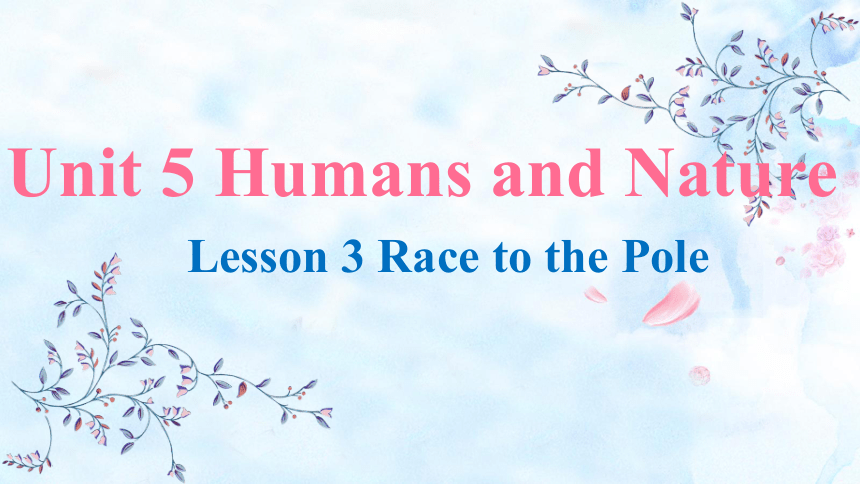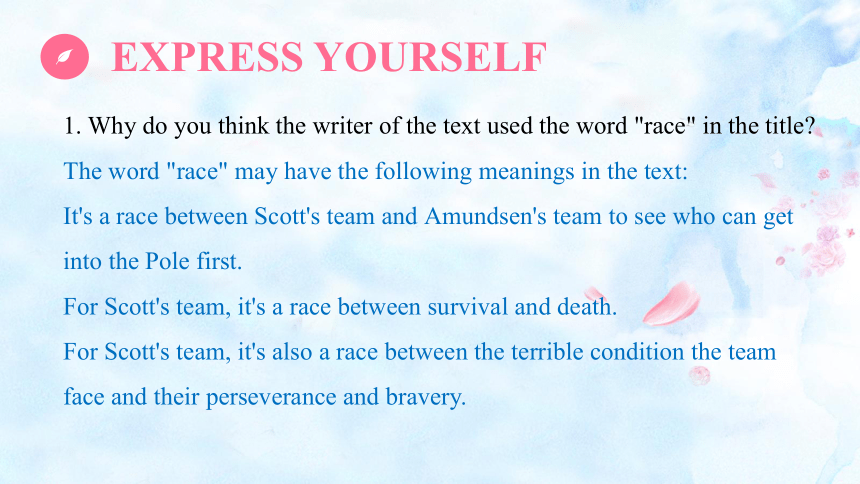北师大版(2019)必修 第二册Unit 5 Humans and Nature Lesson 3 Race to the Pole课件(共30张PPT)
文档属性
| 名称 | 北师大版(2019)必修 第二册Unit 5 Humans and Nature Lesson 3 Race to the Pole课件(共30张PPT) |  | |
| 格式 | pptx | ||
| 文件大小 | 6.9MB | ||
| 资源类型 | 教案 | ||
| 版本资源 | 北师大版(2019) | ||
| 科目 | 英语 | ||
| 更新时间 | 2024-07-22 14:52:53 | ||
图片预览












文档简介
(共30张PPT)
Lesson 3 Race to the Pole
Unit 5 Humans and Nature
READ AND EXPLORE
Scott's
team
Amundsen's
team
The race began
A
S
1911.9.8
1911.11.1
1911.12.14
1912.1.17
1912.1.25
all died
Arrival at the south pole
Arrival at the starting base safely
Nov.1st, 1991
Sept.8th, 1991
1912.1.17
1911.12.14
Arrived back safely on Jan.25th,1912.
Food bases
Food bases
Race to the south pole
Scott from Britain
Amendson from Norway
win the race successfully
lost their lives but left us a great spirit
destination
Teams of dogs
Teams of horses
Never came back alive
The south pole
Group Work
Think and share
1. Would you say that Scott and his team were losers Why or why not
Robert Falcon Scott (1868-1912)
British Royal Navy officer and explorer
Roald Amundsen (1872-1928)
Norwegian explorer of polar regions
Group Work
Think and share
· Even though Scott and his team lost the race to the Pole, they showed true determination and strength of character which is seen as in heroes, which inspires the younger generation to keep exploring the world.
· Scott's team had always kept their goals in mind and did not give up until they reached the South Pole.
· They carried the rocks even in extremely difficult situations. Their courage and selfless devotion helped followers do further research.
They created what is called "the heroic age of Antarctic exploration". Since then, humans have never stopped exploring Antarctica.
Group Work
Think and share
2. How do you understand Amundsen's saying about Scott's death "Captain Scott left a record, for honesty, sincerity, for bravery, for everything that makes a man"
Captain Scott wrote a diary detailing his journey, each entry was truthful and honest. He was honest about the feelings of his team and his fears. Captain Scott and his team brought back rocks for research, they did not only think about themselves but also about the greater good of humankind and the effect of the research.
Pair Work Read the sentences from Scott's diary and letter again.
1. Discuss what he was trying to say in each one.
2. Highlight the parts that impress you most and explain why.
EXPRESS YOURSELF
EXPRESS YOURSELF
Pair Work
Discuss the following questions. Read the text again if necessary.
1. Why do you think the writer of the text used the word "race" in the title
The word "race" may have the following meanings in the text:
It's a race between Scott's team and Amundsen's team to see who can get into the Pole first.
For Scott's team, it's a race between survival and death.
For Scott's team, it's also a race between the terrible condition the team face and their perseverance and bravery.
EXPRESS YOURSELF
2. Why was the world shocked by Scott's death
People were shocked by Scott's death possibly because:
Scott and his team members died so bravely.
They didn't give away the stones even in such bad conditions.
They got within just 11 miles of one of their food bases.
They died in the way of a gentleman.
EXPRESS YOURSELF
Search online for the main events in China's Antarctica exploration. Why do people try to explore the toughest part of the Earth
EXPRESS YOURSELF
China has built four Antarctic research bases, namely
the Great Wall, Zhongshan, Kunlun and Taishan stations.
EXTENDED READING
What was a typical day in Antarctica like on Scott's expedition to the South Pole in 1912 Read this diary extract from Frank Debenham, an Australian on the British Antarctic Expedition from 1910 to 1913 to find out!
Frank Debenham
EXTENDED READING
28 May 1911
"A typical day starts at 8 for breakfast at 8.30 – tho'some are always late…
For breakfast we have porridge, tea and coffee, bread and butter and some dish such as fried seal and bacon or scrambled 'Tru-egg'. The porridge is excellent but as all 25 of us like it there is never quite enough.
EXTENDED READING
Afterwards I start work immediately, which consists of cutting sections, learning German, using the microscope, writing the diary or reading books. When fine I go for a walk, but walks in the dark are most uninteresting. The others fill in their mornings in various ways.
EXTENDED READING
Sunny Jim and Charles are always busy with their meteorological gadgets, setting them up, repairing or taking them down. The ponies are regularly exercised when the weather permits.
Cherry puts in the day typing copy for the South Polar Times or building a stone-hut in which to flense sealskins. Bill is always sketching or painting and Teddy Evans has plenty
EXTENDED READING
of work with chart making and working up the summer's
surveying data. Ponting is regularly engaged in taking prints negatives he made in the summer, or in taking flashlights.
Lunch is at 1:30 and consists of bread (or biscuit) and butter with potted meat, jam and cheese on alternate days, also tea and cocoa. Dinner is at 6:30 and is always a 3-course meal meal—soup, meat and pudding. After each of the meals
EXTENDED READING
a good many sit at the table smoking and talking for a long time. The table breaks up into 2 or 3 groups each with its own subject and there is a general buzz of conversation."
EXTENDED READING
10 fun facts about Antarctica
1. Antarctica holds most of the world's fresh water.
An incredible 60-90% of the world's fresh water is locked in Antarctica's vast ice sheet. The Antarctic ice sheet is the largest on Earth.
EXTENDED READING
2. Antarctica used to be as warm as Melbourne.
Researchers have estimated that 40-50 million years ago, temperatures across Antarctica reached up to 17 ℃ (62.6 ℉).
10 fun facts about Antarctica
EXTENDED READING
3. Antarctica is a desert.
The average annual rainfall at the South Pole over the past 30 years was just over 10 mm (0.4 in).
10 fun facts about Antarctica
EXTENDED READING
4. The Antarctic Peninsula is one of the most rapidly warming areas on Earth.
Over the past 50 years, average temperatures across the Antarctic Peninsula have increased by 3 ℃ (37.4 ℉), five times the average increase on Earth.
10 fun facts about Antarctica
EXTENDED READING
5. There is no Antarctic time zone.
Scientists working in Antarctica generally stay in the time zone of the country they departed from.
10 fun facts about Antarctica
EXTENDED READING
6. Every way is north!
If you stand at the South Pole, you are at the southernmost point on Earth. It doesn't matter which way you look, every direction is north.
10 fun facts about Antarctica
EXTENDED READING
7. There's a subglacial lake that flows blood red.
The water flowing from within the glacier was from a subglacial lake high in salt and oxidised iron, and when it came into contact with oxygen the iron rusted, giving the water its striking red shade, and its name: Blood Falls.
10 fun facts about Antarctica
EXTENDED READING
8. Antarctica has active volcanoes.
Mount Erebus, the second-highest volcano in Antarctica, is the southernmost active volcano on Earth.
10 fun facts about Antarctica
EXTENDED READING
9. Antarctica has its own Treaty.
In December 1959, 12 countries signed the Antarctic Treaty, an unprecedented international agreement to govern the continent together as a reserve for peace and science.
10 fun facts about Antarctica
EXTENDED READING
10. Diamond dust floats in the air.
As ice crystals hang suspended in the air, sunlight causes them to sparkle, creating a glittering effect that looks like a million tiny floating diamonds.
10 fun facts about Antarctica
Thank you
Lesson 3 Race to the Pole
Unit 5 Humans and Nature
READ AND EXPLORE
Scott's
team
Amundsen's
team
The race began
A
S
1911.9.8
1911.11.1
1911.12.14
1912.1.17
1912.1.25
all died
Arrival at the south pole
Arrival at the starting base safely
Nov.1st, 1991
Sept.8th, 1991
1912.1.17
1911.12.14
Arrived back safely on Jan.25th,1912.
Food bases
Food bases
Race to the south pole
Scott from Britain
Amendson from Norway
win the race successfully
lost their lives but left us a great spirit
destination
Teams of dogs
Teams of horses
Never came back alive
The south pole
Group Work
Think and share
1. Would you say that Scott and his team were losers Why or why not
Robert Falcon Scott (1868-1912)
British Royal Navy officer and explorer
Roald Amundsen (1872-1928)
Norwegian explorer of polar regions
Group Work
Think and share
· Even though Scott and his team lost the race to the Pole, they showed true determination and strength of character which is seen as in heroes, which inspires the younger generation to keep exploring the world.
· Scott's team had always kept their goals in mind and did not give up until they reached the South Pole.
· They carried the rocks even in extremely difficult situations. Their courage and selfless devotion helped followers do further research.
They created what is called "the heroic age of Antarctic exploration". Since then, humans have never stopped exploring Antarctica.
Group Work
Think and share
2. How do you understand Amundsen's saying about Scott's death "Captain Scott left a record, for honesty, sincerity, for bravery, for everything that makes a man"
Captain Scott wrote a diary detailing his journey, each entry was truthful and honest. He was honest about the feelings of his team and his fears. Captain Scott and his team brought back rocks for research, they did not only think about themselves but also about the greater good of humankind and the effect of the research.
Pair Work Read the sentences from Scott's diary and letter again.
1. Discuss what he was trying to say in each one.
2. Highlight the parts that impress you most and explain why.
EXPRESS YOURSELF
EXPRESS YOURSELF
Pair Work
Discuss the following questions. Read the text again if necessary.
1. Why do you think the writer of the text used the word "race" in the title
The word "race" may have the following meanings in the text:
It's a race between Scott's team and Amundsen's team to see who can get into the Pole first.
For Scott's team, it's a race between survival and death.
For Scott's team, it's also a race between the terrible condition the team face and their perseverance and bravery.
EXPRESS YOURSELF
2. Why was the world shocked by Scott's death
People were shocked by Scott's death possibly because:
Scott and his team members died so bravely.
They didn't give away the stones even in such bad conditions.
They got within just 11 miles of one of their food bases.
They died in the way of a gentleman.
EXPRESS YOURSELF
Search online for the main events in China's Antarctica exploration. Why do people try to explore the toughest part of the Earth
EXPRESS YOURSELF
China has built four Antarctic research bases, namely
the Great Wall, Zhongshan, Kunlun and Taishan stations.
EXTENDED READING
What was a typical day in Antarctica like on Scott's expedition to the South Pole in 1912 Read this diary extract from Frank Debenham, an Australian on the British Antarctic Expedition from 1910 to 1913 to find out!
Frank Debenham
EXTENDED READING
28 May 1911
"A typical day starts at 8 for breakfast at 8.30 – tho'some are always late…
For breakfast we have porridge, tea and coffee, bread and butter and some dish such as fried seal and bacon or scrambled 'Tru-egg'. The porridge is excellent but as all 25 of us like it there is never quite enough.
EXTENDED READING
Afterwards I start work immediately, which consists of cutting sections, learning German, using the microscope, writing the diary or reading books. When fine I go for a walk, but walks in the dark are most uninteresting. The others fill in their mornings in various ways.
EXTENDED READING
Sunny Jim and Charles are always busy with their meteorological gadgets, setting them up, repairing or taking them down. The ponies are regularly exercised when the weather permits.
Cherry puts in the day typing copy for the South Polar Times or building a stone-hut in which to flense sealskins. Bill is always sketching or painting and Teddy Evans has plenty
EXTENDED READING
of work with chart making and working up the summer's
surveying data. Ponting is regularly engaged in taking prints negatives he made in the summer, or in taking flashlights.
Lunch is at 1:30 and consists of bread (or biscuit) and butter with potted meat, jam and cheese on alternate days, also tea and cocoa. Dinner is at 6:30 and is always a 3-course meal meal—soup, meat and pudding. After each of the meals
EXTENDED READING
a good many sit at the table smoking and talking for a long time. The table breaks up into 2 or 3 groups each with its own subject and there is a general buzz of conversation."
EXTENDED READING
10 fun facts about Antarctica
1. Antarctica holds most of the world's fresh water.
An incredible 60-90% of the world's fresh water is locked in Antarctica's vast ice sheet. The Antarctic ice sheet is the largest on Earth.
EXTENDED READING
2. Antarctica used to be as warm as Melbourne.
Researchers have estimated that 40-50 million years ago, temperatures across Antarctica reached up to 17 ℃ (62.6 ℉).
10 fun facts about Antarctica
EXTENDED READING
3. Antarctica is a desert.
The average annual rainfall at the South Pole over the past 30 years was just over 10 mm (0.4 in).
10 fun facts about Antarctica
EXTENDED READING
4. The Antarctic Peninsula is one of the most rapidly warming areas on Earth.
Over the past 50 years, average temperatures across the Antarctic Peninsula have increased by 3 ℃ (37.4 ℉), five times the average increase on Earth.
10 fun facts about Antarctica
EXTENDED READING
5. There is no Antarctic time zone.
Scientists working in Antarctica generally stay in the time zone of the country they departed from.
10 fun facts about Antarctica
EXTENDED READING
6. Every way is north!
If you stand at the South Pole, you are at the southernmost point on Earth. It doesn't matter which way you look, every direction is north.
10 fun facts about Antarctica
EXTENDED READING
7. There's a subglacial lake that flows blood red.
The water flowing from within the glacier was from a subglacial lake high in salt and oxidised iron, and when it came into contact with oxygen the iron rusted, giving the water its striking red shade, and its name: Blood Falls.
10 fun facts about Antarctica
EXTENDED READING
8. Antarctica has active volcanoes.
Mount Erebus, the second-highest volcano in Antarctica, is the southernmost active volcano on Earth.
10 fun facts about Antarctica
EXTENDED READING
9. Antarctica has its own Treaty.
In December 1959, 12 countries signed the Antarctic Treaty, an unprecedented international agreement to govern the continent together as a reserve for peace and science.
10 fun facts about Antarctica
EXTENDED READING
10. Diamond dust floats in the air.
As ice crystals hang suspended in the air, sunlight causes them to sparkle, creating a glittering effect that looks like a million tiny floating diamonds.
10 fun facts about Antarctica
Thank you
同课章节目录
- Unit 4 Information technology
- Lesson 1 Avatars
- Lesson 2 Apps
- Lesson 3 Internet and Friendships
- Unit 5 Humans and nature
- Lesson 1 A Sea Story
- Lesson 2 Professional Rescue Team
- Lesson 3 Race to the Pole
- Unit 6 The admirable
- Lesson 1 A Medical Pioneer
- Lesson 2 History Makers
- Lesson 3 The Superhero Behind Superman
